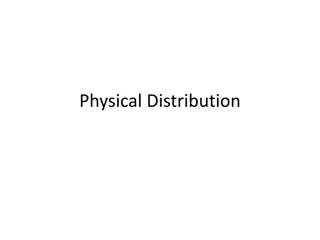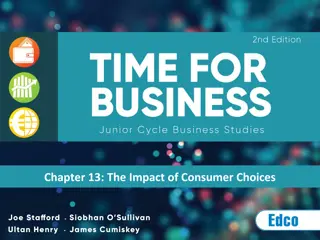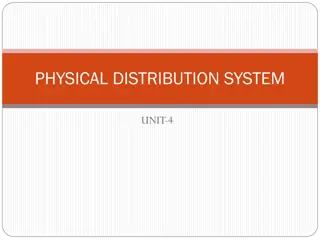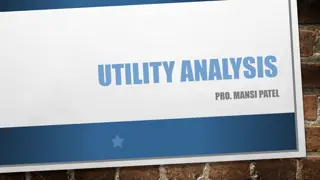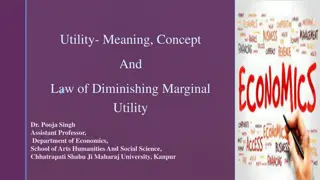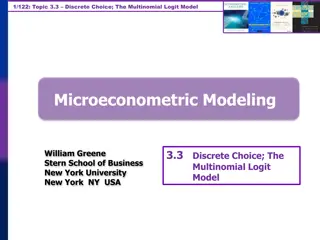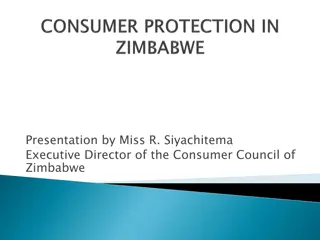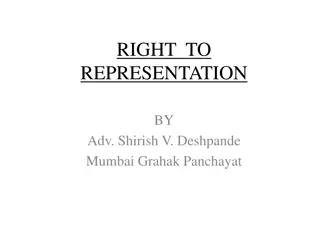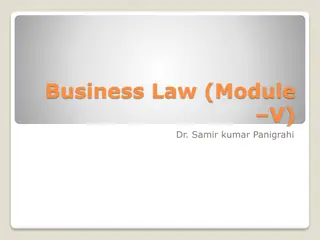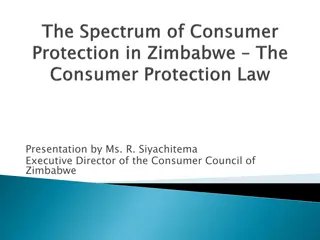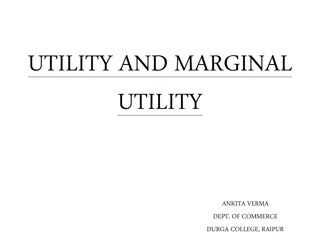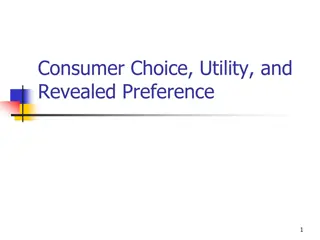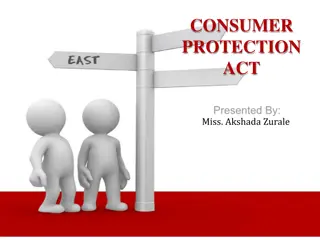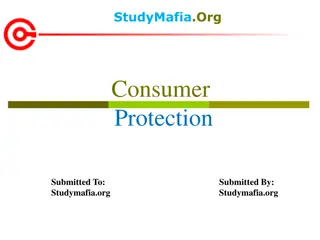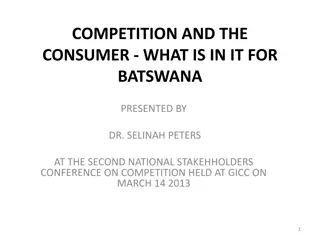Consumer Choices and Utility Maximization
Exploring how consumers make consumption decisions based on utility theory, marginal utility, and preferences. Analyzing Lisa's consumption possibilities, total utility, and marginal utility to illustrate economic concepts. Discussing the utility-maximizing rule for optimal decision-making in spending income on goods and services.
Download Presentation

Please find below an Image/Link to download the presentation.
The content on the website is provided AS IS for your information and personal use only. It may not be sold, licensed, or shared on other websites without obtaining consent from the author.If you encounter any issues during the download, it is possible that the publisher has removed the file from their server.
You are allowed to download the files provided on this website for personal or commercial use, subject to the condition that they are used lawfully. All files are the property of their respective owners.
The content on the website is provided AS IS for your information and personal use only. It may not be sold, licensed, or shared on other websites without obtaining consent from the author.
E N D
Presentation Transcript
UTILITY AND DEMAND Chapter 8
IN THIS CHAPTER WE WILL o Explain how consumer make consumption choices using the concept of utility o Explain the marginal utility theory of consumer choice o Use marginal utility theory to predict the effects of changes in prices and incomes and to explain the paradox of value: you know that diamonds are expensive and water is cheap. Doesn t that seem odd? Why do we place a higher value on useless diamonds than on essential-to-life water?
CONSUMPTION CHOICES The choices you make as a buyer of goods and services is influenced by many factors, which economists summarize as Consumption possibilities: all things that you can afford to buy. Preferences We ll study the consumption possibilities of Lisa, who buys only two goods: movies and pop. Lisa s budget line shows the limits of her consumption possibilities.
Consumption Possibilities Lisa has $40 to spend, the price of a movie is $8 and the price of pop is $4 a case. The table lists seven possible ways in which she can spend her $40. The graphs plots these combinations of movies and pop.
CONSUMPTION CHOICES Preferences The choice that Lisa makes depends on her preferences her likes and dislikes. Her benefit or satisfaction from consuming a good or service is called utility. Total Utility and marginal utility Total utility is the total satisfaction a person gets from the consumption of goods. Generally, more consumption gives more total utility. Marginal utility is the additional satisfaction a person gets from consuming one more unit of a product
TOTAL UTILITY Table 8.1 shows Lisa s total utility schedule. Total utility from a good increases as the quantity of the good increases.
UTILITY-MAXIMIZING RULE Utility-Maximizing Rule A consumer s total utility is maximized by following the rule: Spend all available income and lists all the consumption possibilities Equalize the marginal utility per dollar for all goods
UTILITY-MAXIMIZING CHOICE In row B, MUP/PP < MUM/PM. Lisa spends too much on pop and too little on movies. If Lisa spends less on pop and more on movies, MUP increases and MUM decreases.
UTILITY-MAXIMIZING CHOICE In row D, MUP/PP > MUM/PM. Lisa spends too much on movies and too little on pop. If Lisa spends less on movies and more on pop, MUM increases and MUP decreases.
UTILITY-MAXIMIZING CHOICE In row c, MUP/PP = MUM/PM. Lisa maximizes her total utility.
EXERCISE Max has an income of $35, and rental for windsurfing is $10/hour, for snorkeling is $5/hour. Make a table that shows the various combinations of hours spent on windsurfing and snorkeling that Max can afford. Add two columns and list max s marginal utility per dollar from windsurfing and from snorkeling. How many hours on each activity would maximize his total utility? a. b. c.
PREDICTIONSOF MARGINAL UTILITY THEORY We use the Marginal utility theory to predict the effects of: a price change: a fall in the price of a movie; a rise in income.
PREDICTIONSOF MARGINAL UTILITY THEORY Movie s price falls from $8 to $4, Table 8.3 shows Lisa s just-affordable combinations. Before Lisa changes what she buys MUM/PM > MUP/PP. To maximize total utility, Lisa sees more movies and drinks less pop.
PREDICTIONS Figure 8.4 illustrates these predictions. A fall in the price of a movie increases the quantity of movies demanded a movement along the demand curve for movies, and decreases the demand for pop a shift of the demand curve for pop.
PREDICTIONSOF MARGINAL UTILITY THEORY A Rise in Income Given the prices of movies and pop, when Lisa s income increases from $40 to $56 a month (price is $ 4 each).
PREDICTIONSOF MARGINAL UTILITY THEORY Table 8.5 shows Lisa s just- affordable combinations when she has $56 to spend. With $40 to spend, Lisa sees 6 movies and drinks 4 cases of pop a month. With $56 to spend, She sees 8 movies and drinks 6 cases of pop a month.
PREDICTIONSOF MARGINAL UTILITY THEORY The Paradox of Value Why is water, which is essential to life, far cheaper than diamonds, which are not essential? To solve the puzzle, we need to differentiate total utility and marginal utility. We use so much water that the marginal utility from water consumed is small, but the total utility is large. We buy few diamonds, so the marginal utility from diamonds is large, but the total utility is small.
DISCUSSION QUESTIONS Discuss why newspaper publishers are prepared to use vending machines that allow customers to pay for one newspaper and remove several, whereas candy and soft-drink producers use vending machines that allow customers to remove only the single product that is purchased. Many medical and hospital services in Canada are provided at zero cost to all Canadians and are financed out of general government revenues. What would be the marginal value of such services consumed by each Canadian if the government provided the necessary resources to satisfy all demand? How does this relate to the total value that Canadians probably place on medical services? Why dentists choose to work 4 days a week, while they are fully booked for the next two weeks? Don t they want to maximize their total utility?
EXERCISE Max is offered a special deal on windsurfing equipment: a rental rate of $5 an hour. His income remains at $35 a day and the rental price of snorkeling equipment remains at $5 an hour. a. how many hours does Max spend on windsurfing and how many hours does he spend on snorkeling? b.How does Max s demand for snorkeling change when the price of windsurfing rental falls. What is Max s cross elasticity of demand for snorkeling with respect to the price of windsurfing? Are windsurfing and snorkeling substitutes or complements for Max?
EXERCISE Max gets an increase in income from $35 to $55 a day. Windsurfing equipment rents for $10 an hour, and snorkeling equipment for $5 an hour. Show the effect of the increase in Max s income on Max s demand curve for a. windsurfing, and explain whether, for Max, windsurfing is a normal good or an inferior good b. snorkeling equipment, and explain whether, for Max, snorkeling is a normal good or an inferior good
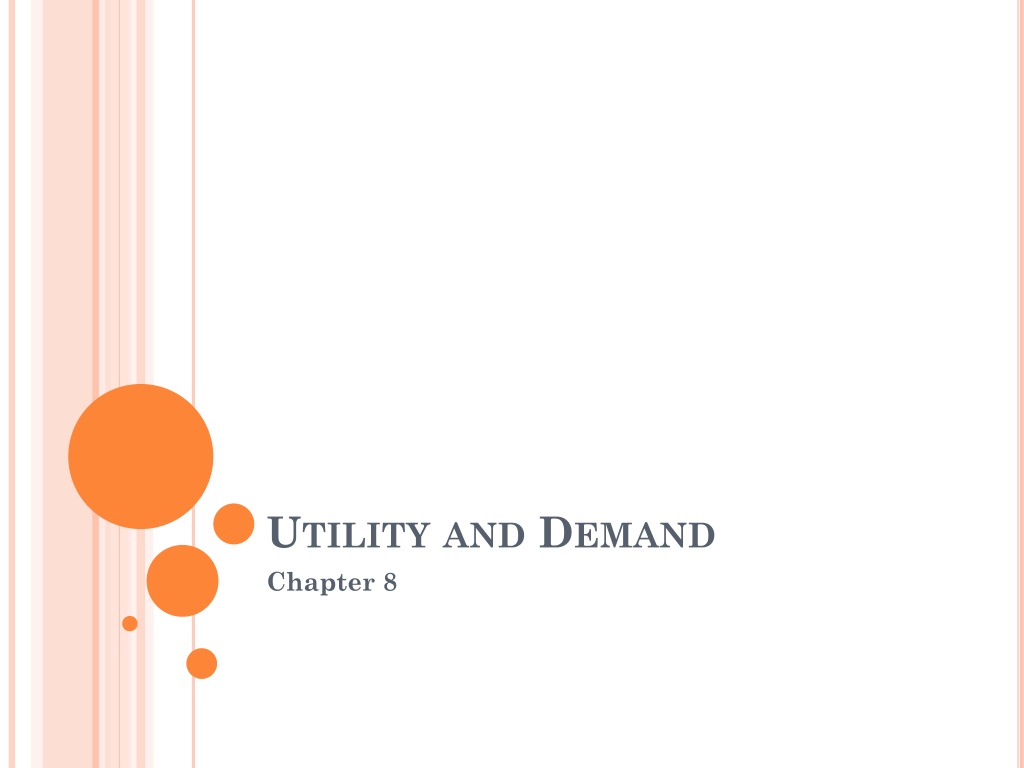
 undefined
undefined

















